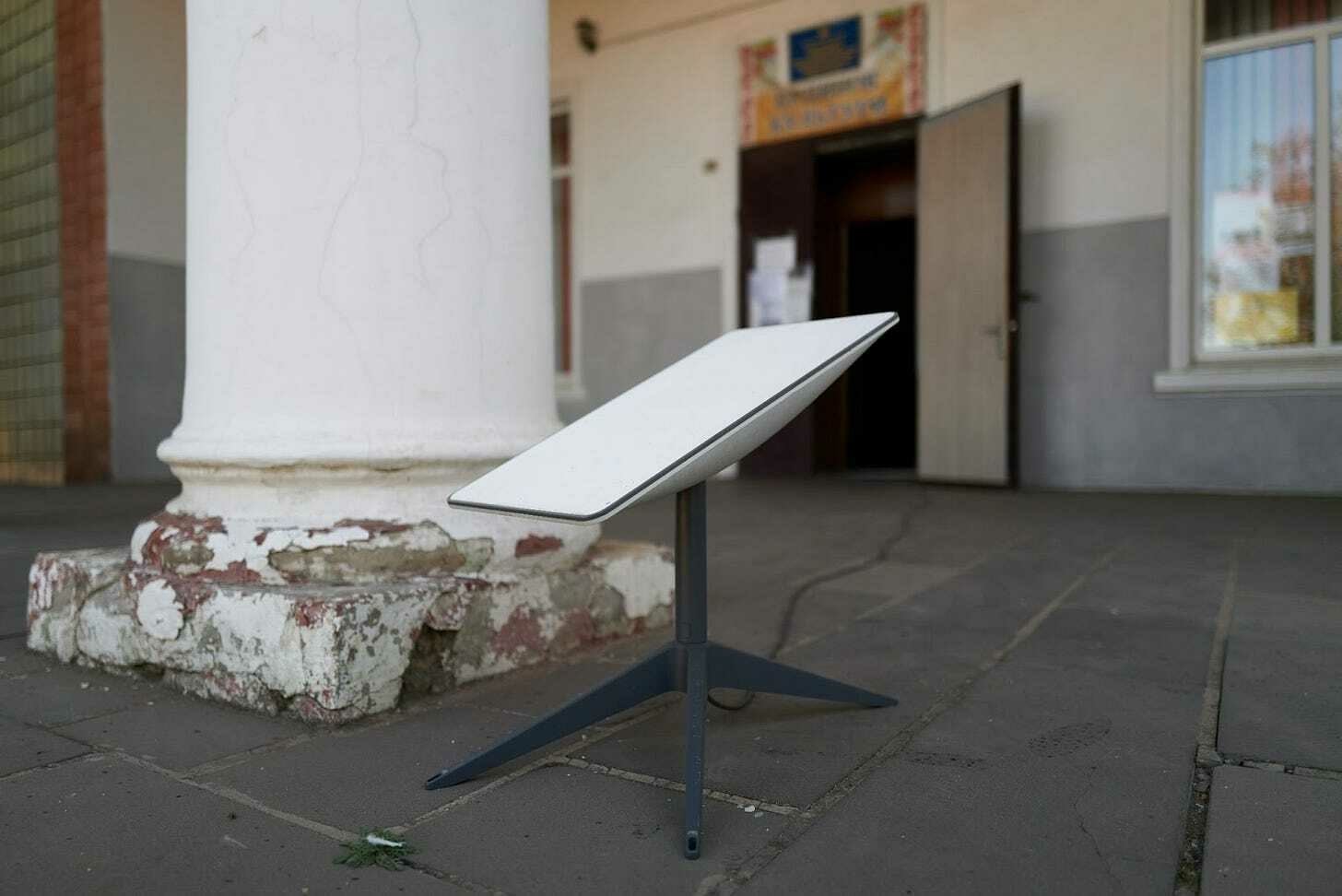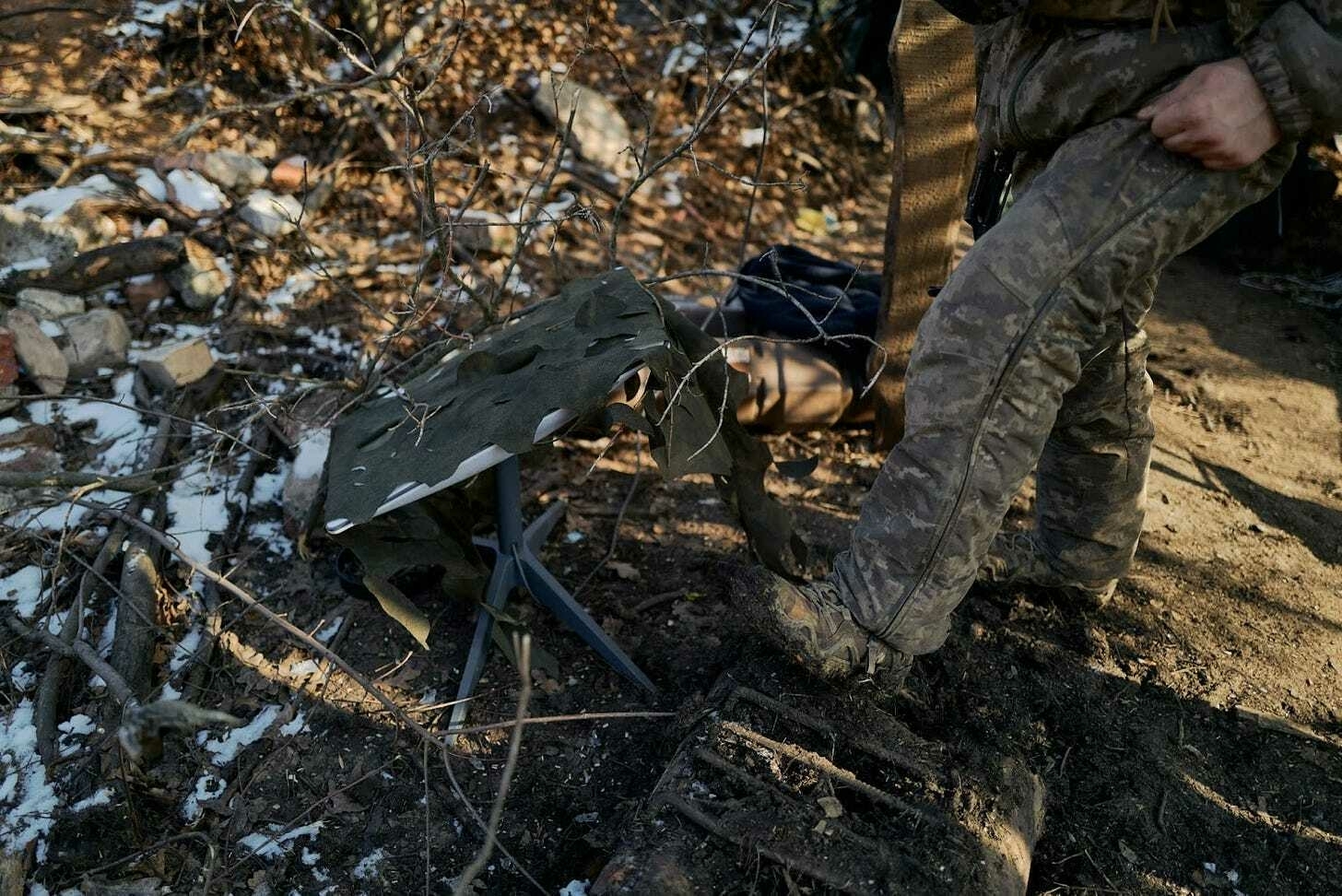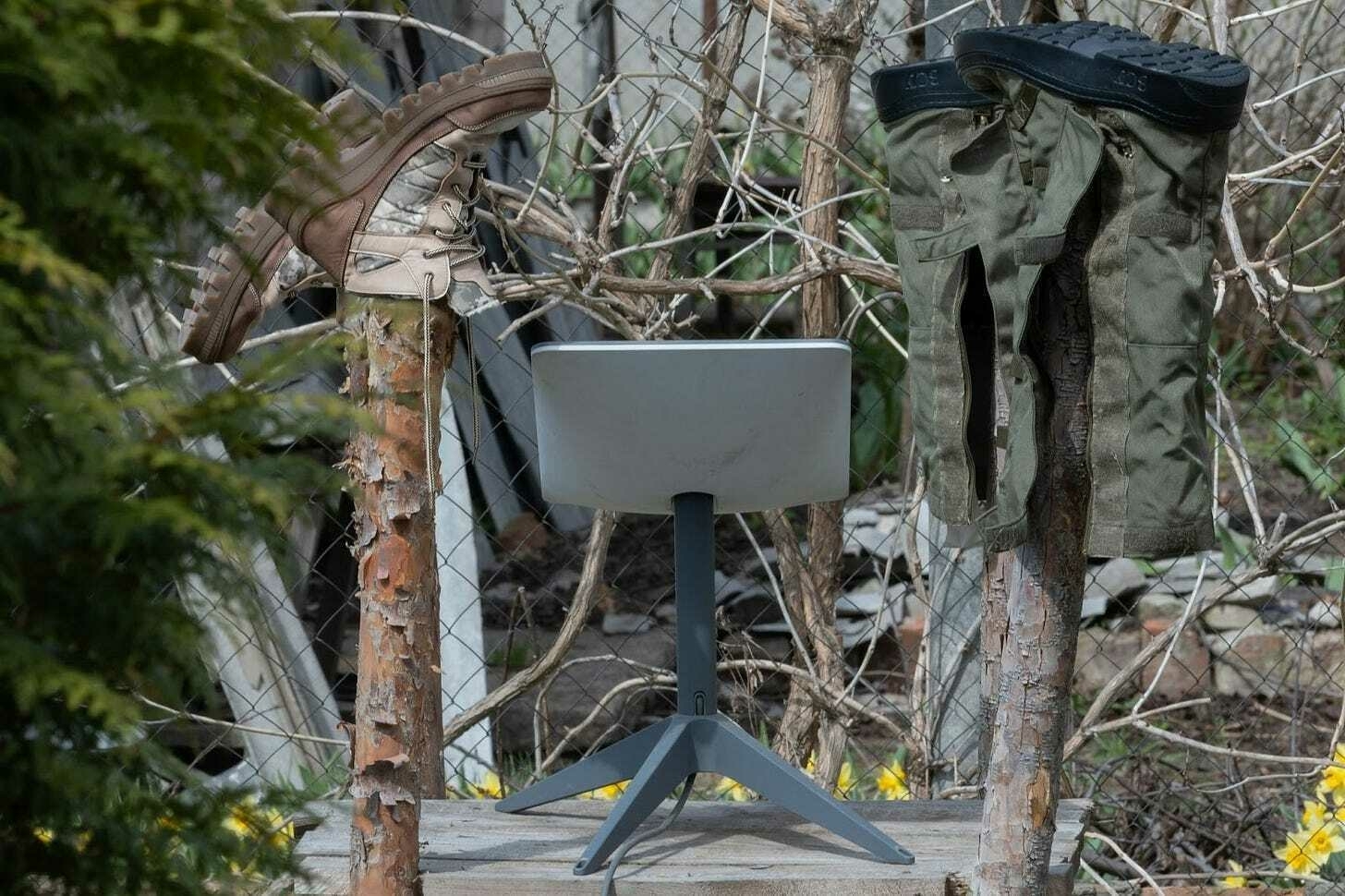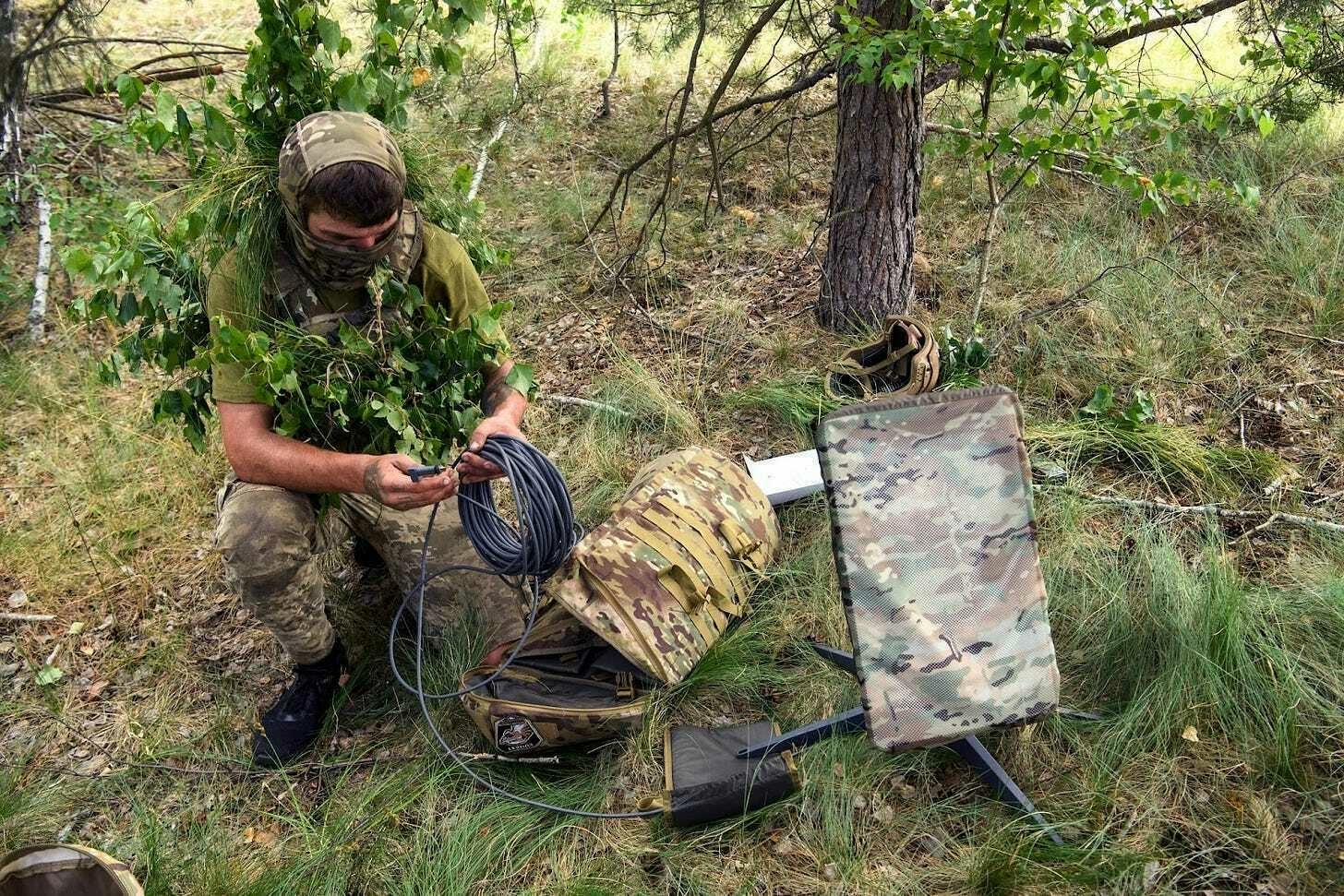Editor’s Note: We go deep into the lives of those who have been most affected by this war.
We don’t just opine about the state of world affairs. We do thorough reporting, introducing you to the human stories of those living through global events – and teach you something new with every issue.
Don’t let our work go unnoticed. Upgrade today to support us!
TOMORROW: Thursday at 7am Pacific, 10 am Eastern, 5pm Kyiv – watch Tim Mak and Alexander Vindman on our new show – catch it at Counteroffensive.News or the Substack app.
After a busy day at work as a software engineer, Oleg Kutkov returns to his apartment in Kyiv. He goes out to the balcony, but not to smoke or water the flowers.
Oleg’s balcony is a workshop. Here he repairs Starlink terminals damaged at the front, and sends them back to soldiers.
"At first, I used to work with Starlink as a hobby. But when I fix them now, I realize that it is not just a hobby, it is the main means of communication at the front,” Oleg said.
Hundreds of thousands of people in Ukraine (including The Counteroffensive’s Kyiv offices) depend on Starlink satellites, which have replaced internet networks that have been damaged during the war. Civilians in hospitals, schools, and frontline areas all rely on it – as does the military along the entire frontline.
But President Trump and Elon Musk see Starlink as a great way to put pressure on the Ukrainian government. Starlink is part of Musk’s SpaceX company, and although Ukraine and its partners pay for the operation of Starlink terminals, Musk can theoretically turn them off whenever he wants.
The centrality of Starlink to Ukrainian military success highlights just what an important geopolitical figure Musk has become, and how the world’s richest man has influence well beyond his net worth. In fact, the trajectory of the war is very much in the hands of one person.
Although Ukrainian soldiers realize that there are no alternatives to Starlink, they can fight without it – simply because Ukrainians have no choice. The solution may be to switch to more traditional means of communication, including radios and cell phone networks. It is also possible to partially switch to satellite communications from other companies. But the Starlink alternatives are less efficient, and will not be able to cover the entire front line.
Since childhood, Oleg Kutkov, who is now 36, has loved disassembling and reassembling various devices. So when he heard about the Starlink system in 2021, he knew it would interest him.
Oleg ordered his first terminal from the US at the end of 2021. Back then, Starlink connection was not yet available in Ukraine. Oleg was more interested in taking apart the satellite terminal and seeing how it worked inside.
Oleg’s was probably the first Starlink in Ukraine, he said.
A few months later, the full-scale invasion began. In late February 2022, Kyiv asked Elon Musk to provide Ukraine with Starlink access. This was necessary because Russia was attacking communication towers and disrupting access to traditional systems.
The billionaire can give, and he can take away – such is his hold over his company. A few hours later, Musk replied that Starlink communication was now active in Ukraine, and the first terminals were on en route.
Oleg saw Musk's tweet and decided to try to activate his terminal. His contacts at SpaceX helped him with this, and the terminal worked. He believes it was one of the first activations in the entire country.
“It allowed me to at least somehow stay in touch and get some news [When Oleg was in Kyiv at the beginning of the full-scale invasion]. Where there was no connection due to Russian attacks, it appeared thanks to Starlink,” Oleg said.

Despite helping Ukraine at the start of the war, later, Musk began to undermine the operations of the Ukrainian military.
In September 2023, biographer Walter Isaacson claimed that Musk had secretly turned off Starlink access near the occupied Crimea the year before, to disrupt an attack on the Russian fleet. This information was also confirmed by Kyrylo Budanov, Ukraine’s military intelligence chief.
In February 2023, SpaceX restricted the use of Starlink in Ukraine, in particular restricting its ability to control drones in the region. Elon Musk said that his company did this “to prevent World War III.” The restrictions were eventually lifted.
New threats over shutting down the Starlink satellites emerged more recently when Trump returned as American president. Trump administration negotiators threatened to cut off Ukraine's access if it did not sign a minerals deal, Reuters reported.
The deal remains unsigned.
There was also a fight between Polish Foreign Minister Sikorski and Musk over the possible shutdown of Starlink. Although it ended with a tweet from Musk that he would never turn off access, there is doubt about whether his word alone can be trusted.
Ukraine is still vulnerable to the possibility that Starlink will be turned off and the army will be left without communication. So it has to look for alternative means of communication.
“I know that Starlink is not reliable, as SpaceX has shut it down several times. But currently, there are no full-fledged alternatives, all other options are worse,” said Oleg.
Using Starlink, the military can coordinate combat operations, transmit data from the front line, and quickly monitor the situation on the battlefield – even when there is mobile network coverage.
It can also control strikes and reconnaissance missions by drones.

“Communication [provided by Starlink] is the basis of command and control. If there is communication, then there is control, and then we can talk about offense, defense, and everything else,” said Yaroslav Honchar, who heads the NGO Aerorozvidka, which promotes the introduction of robotic military capabilities.
Although Starlink is not officially available to the Russian army, it has been reported that some Russians have used it anyway.
Nonetheless, Starlink has its drawbacks. That’s largely because Starlink has insufficient durability for extended use on the battlefield. As a result, the terminals often break when they are used in extreme conditions.
The most common problem people come to Oleg with is to repair a Starlink after it was hit by shrapnel. And in trenches, terminals are often flooded with water or gnawed at by rodents, or can fall off the vehicle at speed.
“There was a case when I drained 5 liters [approximately 2.6 gallons] of water from two new terminals. I dried them out, repaired them, and they started working,” Oleg said.

The main reason why Ukraine began to look for an alternative to the Starlink system in earnest is to reduce its dependence on Musk.
According to the Financial Times, the EU is currently negotiating with four similar operators to potentially replace Starlink in the Armed Forces. These include Luxembourg's SES, Spain's Hisdesat, Britain's Viasat, and France's Eutelsat/OneWeb.
The first three companies have outdated technology. Their satellites are too high above the ground, about 30,000 km, while Musk's satellites are only between 500 and 800 km away. This distance increases signal transmission time.
Eutelsat/OneWeb satellites are located much closer to the Earth at a distance of 1,200 km, similar to Starlink. However, the Starlink satellite network is much larger – with more than 6,000 satellites, compared to just five or six hundred Eutelsat/OneWeb satellites. This also affects the speed and quality of communication.

The other alternatives are more primitive technologies. During the Kursk operation, Ukrainian forces used radio stations or wired communication, as Starlink does not work in Russia.
“We can successfully defend the country without Starlink. We did it at the very beginning of the full-scale invasion, and we can do it now. It is more difficult, more expensive… but it is possible,” added Volodymyr Stepanets of the initiative ‘Narodnyi Starlink,’ which deals with the repair and procurement of Starlink terminals in Ukraine.
At the same time, Volodymyr Stepanets believes that disconnecting Starlink is not only bad for Ukraine, but also for Musk himself. According to him, there are currently more than 150,000 Starlink terminals in Ukraine, and monthly subscription fees alone bring the company about $15 million.
“As a country, we are Musk's largest customer on this continent. Probably, the number of Starlink terminals in Ukraine is higher than in the whole of Europe,” he said.
The Counteroffensive sent a letter of inquiry to the Ministry of Digital Transformation and the Starlink office in Ukraine to determine the official number of Starlink terminals in Ukraine. At the time of publication, we did not receive a response.
Oleg has personally worked on Starlink Gen 2 terminals, which feature a vulnerability when it comes to use in the field. One of the connections used for the cable between the equipment was susceptible to moisture getting into the system, and so easily failed.
So Oleg had to figure out how to use another company's connector, which would be more resistant to moisture. He tried it out for himself, then recorded a video to show others how to do it.
So, like Ukrainians have done for years, he made do with what he had. He adapted, innovated and showed how to replicate his idea. He made more with less.
Under pressure, Ukraine’s creativity shines – and would even if Elon turned off the Starlink terminals.
In this time of great uncertainty — and unstable American support — it means that the situation on the ground is very dangerous. Your contributions help us get the body armor, medical gear, and supplies we need to stay safe.
Show your support by contributing to our tip jar - funds go towards keeping us safe and ensuring our work continues.
Tim Mak x The Bulwark’s Jonathan V. Last
Are we looking at a trifurcation of the world due to Trump’s tariffs? And, Tim and JVL discuss how changing drone technologies are shifting the economics of battlefield combat.
NEWS OF THE DAY:
Good morning to readers; Kyiv remains in Ukrainian hands.
RUSSIA LAUNCHES NEW ASSAULT ON SUMY, KHARKIV REGIONS: Russian troops have already begun an offensive in the Sumy and Kharkiv regions, according to Oleksandr Syrsky, the head of the Ukrainian military.
This is evidenced by Russian offensive operations in those areas, which have nearly doubled over the past week. The offensive's intensity is increasing daily despite international negotiations aimed at a ceasefire. Earlier, Ukrainian President Volodymyr Zelenskyy said Russia was preparing for a spring offensive in the Sumy and Kharkiv regions.
UKRAINIAN STEELMAKER RECEIVES FIRST COAL FROM U.S.-BASED MINE: Ukrainian steelmaker Metinvest has received its first shipment of 80,000 tons of coking coal from its plant in the United States. Coking coal, a key ingredient in steel production, is essential for maintaining Ukraine’s industrial and defense capabilities. The shipment was organized to replace losses caused by the closure of the Pokrovska mine in the Donetsk region, which ceased operations due to the threat of a Russian offensive.
The company plans to organize regular deliveries to maintain the stable operation of the Zaporizhstal and Kamet Steel plants. Each vessel is expected to carry approximately 80,000 tons of raw materials monthly.
CHINESE SOLDIERS FOUGHT IN THE RUSSIAN ARMY FOR MONEY: Chinese soldiers captured by Ukrainians in the Luhansk region on April 8 fought in the Russian army for money, according to Ukrainska Pravda. One of them said that he had been paid 300,000 rubles (approximately US$3,480) through an intermediary in China to join the Russian Armed Forces. He also hoped to obtain Russian citizenship in return.
The Ministry of Foreign Affairs of Ukraine summoned the Charge d'Affaires of China and condemned the participation of Chinese citizens in the war against Ukraine. The Chinese side said it was checking the information received. In the Lugansk region, the Ukrainian military captured two Chinese citizens who had fought on the side of the Russian army.
RUSSIAN SOLDIERS EAT MEDICINE DUE TO HUNGER ON FRONTLINES: Ukrainian military intelligence (HUR) intercepted a conversation revealing a critical situation regarding the Russian military's supplies at the front. A woman mentions that her friends have been sitting in a dugout for two weeks and have run out of food, forcing them to consume even their medicine — Teraflu (anti-cold powder).
This is not the first case; in 2022, the SBU published intercepts revealing that Russian soldiers admitted to eating a Yorkshire terrier out of hunger.
DOG OF WAR
Today's dog of war is Tosha from Mykolaiv. He was there during the entire occupation of Kherson, a neighboring large city, so he heard the shelling of Russian artillery systems almost every day. But now Kherson is free, and Mykolaiv is calmer, so he is happy.
Stay safe out there.
Best,
Artem



